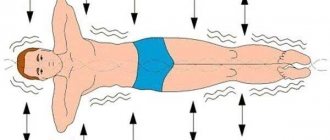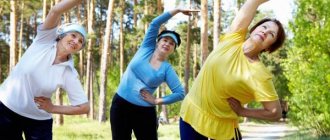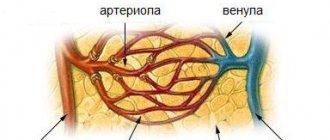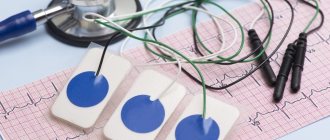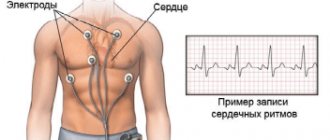For certain diseases, special exercises are an important treatment measure. Cardiac arrhythmia is no exception. Despite the fact that with this pathology a number of loads are contraindicated, proper gymnastics for cardiac arrhythmia can significantly alleviate the patient’s condition. Let's consider what it is and what it may include.
Exercises for cardiac arrhythmia: benefits
Anaerobic exercise helps maintain muscle tone and restores normal functioning of the heart muscle. Breathing exercises for cardiac arrhythmia are the basis for the treatment and prevention of attacks. It helps patients restore their breathing rhythm and normalize blood circulation.
For heart pathologies, exercises are prescribed to normalize the functioning of the entire cardiovascular system. However, in case of arrhythmia, the complex must be selected so as to prevent overvoltage. Exercises are selected taking into account all the characteristics of the disease and are done under the supervision of a specialist. It is important to strictly follow all the doctor’s recommendations and not violate the sequence of exercises.
Gymnastics, which is indicated for arrhythmia, does not involve high loads. It helps improve blood circulation and heart rate, charges the body with vigor and energy.
Massage
In the treatment of arrhythmia, in addition to medications, acupressure . Like any therapy, it has its own technique, indications for use and contraindications. Acupressure allows you to urgently improve the patient’s well-being. The principle of this technique is to work out biological points on the body. In this case, the occurrence of adverse reactions is excluded. The massage performed allows you to:
- facilitate cardiac work by ensuring peripheral vasodilation;
- improve blood supply to the heart;
- normalize metabolism in the body;
- minimize congestion during blood movement;
- increase the pumping capacity of the heart.
Massage for the treatment of heart rhythm can be prescribed in conjunction with drug therapy or be an independent course. When influencing biological active points, stroking, vibration pressure, pinching, rotating and tapping techniques are used. The massage therapist uses the fingertips, hands, elbows and fingers themselves. The massage is done slowly with alternating techniques used. If there are contraindications, acupressure is not performed.
Breathing exercises for cardiac arrhythmia
Breathing exercises are prescribed to patients to restore oxygen supply to the brain, normalize heart rate and prevent hypoxia.
The exercises are performed every day - in the morning before breakfast and at night.
The complex includes the following exercises:
- Warm up. Stand up and take a few small, quick breaths in and out. And at the same time, begin to slowly walk in place, taking each step as you inhale.
- The exercise is performed in a standing position. Lower your hands down, while inhaling sharply, quickly clench your palms into fists as far as you can, and while exhaling, unclench them. Make six turns with breaks of 25 seconds.
- Place your arms along your body, spread your legs shoulder-width apart. Exhale slowly while leaning forward and stretching your arms. As you exhale, straighten up and lower your arms. Do no more than 13 repetitions, then rest.
- Stand up, clench your two hands into a fist, place them on your waist. Unclench your fists and lower your arms while inhaling sharply. As you exhale, return to the starting position.
The number of breaths needs to be increased every day.
If you feel dizzy, stop exercising. You cannot overload the body. Start with a small number of repetitions and gradually increase it. Breathing exercises can be performed not only for arrhythmia, but also for prevention. They have a beneficial effect on the functioning of all organs and systems, helping to saturate them with oxygen.
Need for movement
This is how a person is designed - to be healthy, he must be physically active. Roughly, you can compare the body to a car - when buying a car, it is better to take an old one, but which drives regularly, than a new one, which has stood in the yard of the house for several years and has never started. Therefore, even if a person is sick, even if he has difficulty getting out of bed, he needs movement. The only question is in doses - the patient needs to recover and return to his former life, and not harm himself with excessive zeal.
Not only the functioning of the body depends on movement, but also mood, the ability to work mentally, movement also distracts from difficult thoughts about illness, thus the future life comes to the fore, and not thoughts about sad prospects. People with a diseased heart and blood vessels need aerobic exercises, that is, those that force them to move with free breathing, without static stress and temporary stoppage of lung function.
Loads should be every day and gradually increase. First, you can do exercises in a sitting position, walk slowly, then complicate the set of exercises. There is no point in rushing - with daily effort, a person can feel completely healthy after many months, and possibly several years. To determine the condition of the heart, a cardiologist conducts special tests, diagnostic studies with different types of loads and determines the pace of exercise. In rare cases, exercise is not allowed at all until the cardiac condition normalizes.
Buteyko gymnastics for cardiac arrhythmia
Dr. Buteyko’s gymnastics for arrhythmia are popular. It is based on training in proper breathing. Initially, the method was used to treat bronchial asthma, but over time it was discovered that it helps to effectively treat other diseases.
The essence of the exercises is to relax the diaphragm and reduce the depth of breathing. The complex includes the following exercises:
- Take a small breath through your nose so that your stomach and chest remain motionless. Hold your breath for five seconds, exhale smoothly and continuously. The exhalation should last for 4-5 seconds. There is a pause for the same amount of time. The exercise is performed ten times.
- Combining the diaphragm and chest breathing. Relax, inhale deeply (for 7.5 seconds), first filling the diaphragm with air, and then the chest. Then exhale slowly, starting with your lungs. Pause for five seconds, then repeat the exercise 10 times.
- During pauses, perform a relaxing nose massage.
- Perform 10 full breaths, first on one side of the nose, then on the other.
- After taking a full breath and drawing in your stomach, hold your breath for 7.5 seconds, then rest. Repeat the exercise 10 times.
- Take 12 breaths. The inhalation should last about two seconds. The exercise is performed for a minute.
- Then very rare level breathing is done.
These exercises help strengthen the cardiovascular system and prevent new heart diseases. But before starting the technique, you need to consult a doctor, since it has contraindications.
Physical exercises for cardiac arrhythmia
Physical activity is an important treatment for arrhythmia. But it must be correct and moderate. In addition, regularity is important. In addition to special exercise therapy for arrhythmia, the following sports may be useful as prescribed by a doctor:
- Swimming. Helps maintain muscle tone.
- Walking in place.
- Walking outside.
- Slow running.
- A ride on the bicycle. Helps to engage a large number of muscle groups and restore the correct breathing rhythm.
In the first weeks after discharge from the hospital, the pace of simple walking should be no more than 100 steps per minute. To monitor this, you can use a special pedometer. Over time, the number of steps increases to 150 per minute.
You can start running after 2-3 months. At first, the distance should be no more than 300 meters. After a week it can be increased by another 100 meters. The pace should be slow.
Exercising for arrhythmia: exercise
Exercise for arrhythmia also plays an important role. Exercises are performed in the morning and evening. They help maintain normal functioning of the cardiovascular system and strengthen blood vessels, which is especially important for elderly patients.
Gymnastics for the heart for arrhythmia may include the following exercises:
- Pull-ups on toes. In this case, your feet should be positioned shoulder width apart. Control your breathing while doing this. The number of approaches is from 12, with breaks of 7-10 seconds between them.
- Arm curls. Performed while inhaling and exhaling, up to 14 times per approach. Breaks should be no more than five seconds.
- Turns. Place your feet shoulder-width apart and place your hands on your waist. It is done, like other exercises, while inhaling and exhaling. When turning, you can spread your arms to the sides.
For arrhythmia, squats can be useful, but it is important to do them extremely carefully, no more than ten times with a break of a minute. Squats on one leg are prohibited. Charging is completed in the usual step on the spot for 2-3 minutes.
How to stop an attack of tachycardia
Special exercises and techniques can help stop an attack of tachycardia at its first signs.
- Take a deep breath and hold your breath, while trying to push the air down.
- Breathe deeply for 5-10 minutes: take a deep breath and exhale slowly (3 times longer).
- Press your fingers firmly on your eyeballs (until it hurts) for 10 seconds, then release. Continue this action for several minutes.
- Fill a basin with ice water and immerse your face in it for a few seconds. You can simply wash your face with cold water. The temperature change should cause your heart rate to drop.
- Sometimes a strong cough or artificially induced vomiting helps stop the attack.
If the condition does not improve and the pulse exceeds 120 beats per minute, immediately seek medical help.
Exercise therapy for arrhythmia
Treatment of arrhythmia with physical exercises involves a whole complex of special gymnasts. The doctor must create an individual program based on the severity and extent of the disease, the nature of its course, and the recovery time that the body needs. The load on the body must be strictly dosed.
The exercises differ in the following ways:
- Anatomically. The complex can be developed for individual muscle groups.
- By independence. Exercises can be passive, prescribed for disorders of motor activity, as well as active, which the patient can perform independently.
To achieve results, exercises are performed to strengthen certain muscle groups. Over time, muscle tissue adapts to physical activity, and disturbances caused by arrhythmia are gradually corrected.
Exercise therapy is also prescribed for atrial fibrillation. However, you should not perform exercises on your own, as they may worsen the condition. Gymnastics should be carried out under the supervision of a doctor.
Therapeutic exercise helps to increase the effectiveness of drug therapy many times over, restore normal motor activity, heart rate, and blood circulation. However, it is important that the exercises are appropriate to the patient's medical history.
What exercises are prohibited for arrhythmia?
Not all activity will be beneficial for arrhythmia. For example, strength exercises with weights are prohibited. They can have a negative effect on the heart muscle.
Isometric exercises are also not recommended. With intense work of muscle tissue, blood circulation improves, but there may be a lack of oxygen in the heart area.
The use of barbells, dumbbells, expanders, and strength training equipment is prohibited.
For arrhythmia, exercises that involve holding your breath and staying in one position for a long time are not recommended. It is recommended to refrain from yoga and exercises to pump up the abdominal muscles.
Strength training involves sudden movements during exercise, which can cause deterioration in well-being, dizziness, and heart pain. Any load for arrhythmia should be moderate and dosed.
Causes of the disease and symptoms
Arrhythmia is divided into tachycardia (rapid heartbeat) and bradycardia (slow heartbeat).
Enter your pressure
Move the sliders
120
on
80
The causes of this disease can be different. They are often associated with stressful situations and nervous tension. Arrhythmia is caused by excessive use of medications and folk remedies. This disease is caused by severe poisoning, as well as some viral diseases. But there are cases when arrhythmia is caused by other factors. Among the most common:
- cardiac ischemia;
- poor blood circulation;
- diabetes;
- smoking, excessive consumption of caffeine and alcohol.
Arrhythmia is usually detected during a routine examination by a cardiologist. The patient rarely experiences symptoms. But, if they exist, they are expressed:
- chest pain;
- feeling of heartbeat;
- shortness of breath;
- dizziness;
- loss of consciousness.
Contraindications
In some cases, physical exercises and breathing exercises are contraindicated for cardiac arrhythmia. These include the following:
- Excessive disturbance of heart rhythm. This often occurs after a heart attack. Tachycardia may occur, and atrial fibrillation may become chronic.
- Regular attacks of angina, which mainly occur during physical activity.
- Insufficient amount of blood passing through the vessels.
- Impaired blood circulation due to congenital and acquired heart defects.
- Second or third degree of heart failure.
- Certain diseases of the kidneys and liver, thyroid gland.
- Hypertension.
- Inflammation of the walls of blood vessels of the lower extremities, accompanied by thrombophlebitis.
- Cardiac or aortic aneurysm if there is a threat of rupture.
There are quite a few contraindications to gymnastics, which is why you should not perform it without a doctor’s prescription. The specialist must take into account all the points and prescribe the most suitable complex.
Physical activity is good for the whole body. Proper muscle function helps restore blood circulation, activate brain activity, and normalize heart function. Loads need to be increased gradually. And, of course, remember that it is important to follow all the doctor’s recommendations.
We suggest watching a video with exercises for arrhythmia.
conclusions
Adequate physical activity is indicated for almost all patients with rhythm disturbances during the absence of an attack. The main thing is to select it together with a cardiologist during functional stress tests. The required level of energy expenditure is calculated using the formula depending on the maximum heart rate: the person’s age must be subtracted from two hundred and twenty. 75% of this value is a frequency that cannot be exceeded during training. A competent approach to physical education significantly improves the patient’s quality of life.

